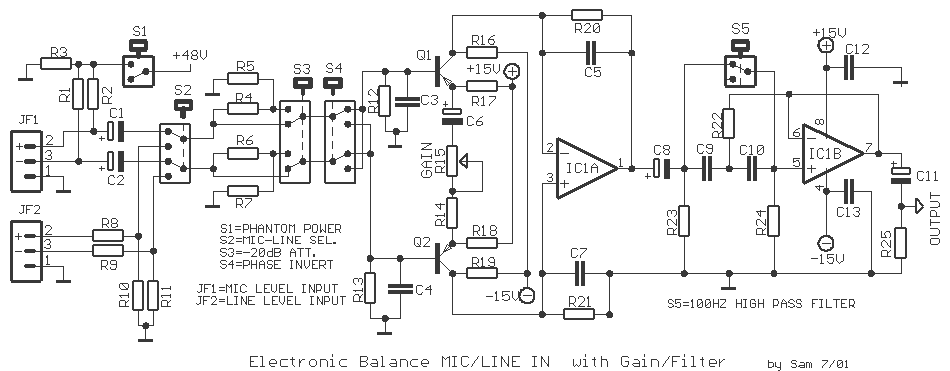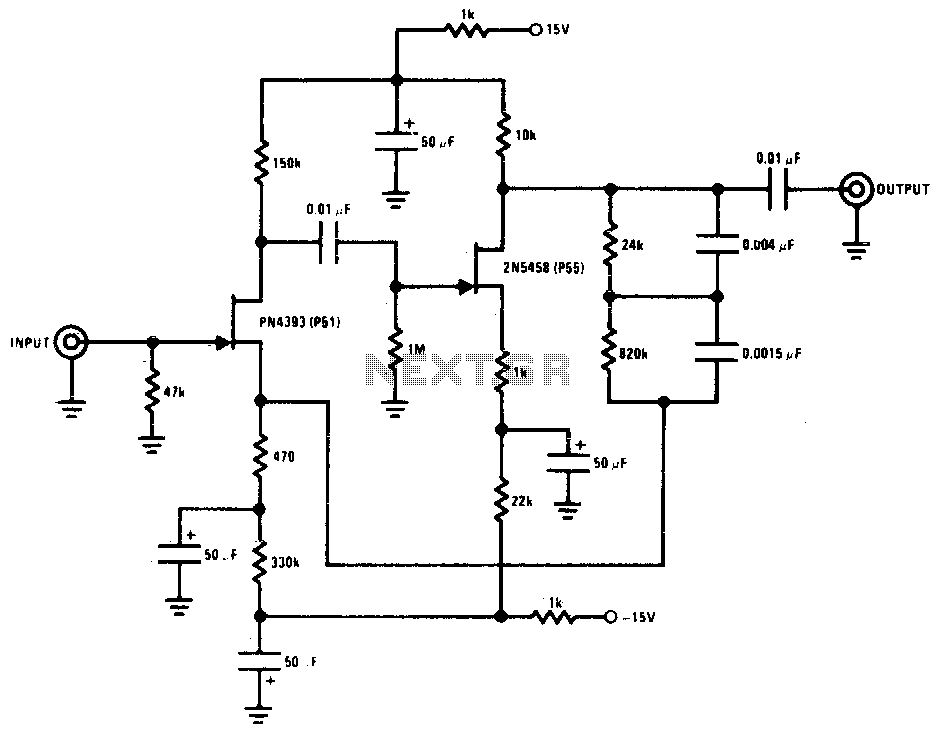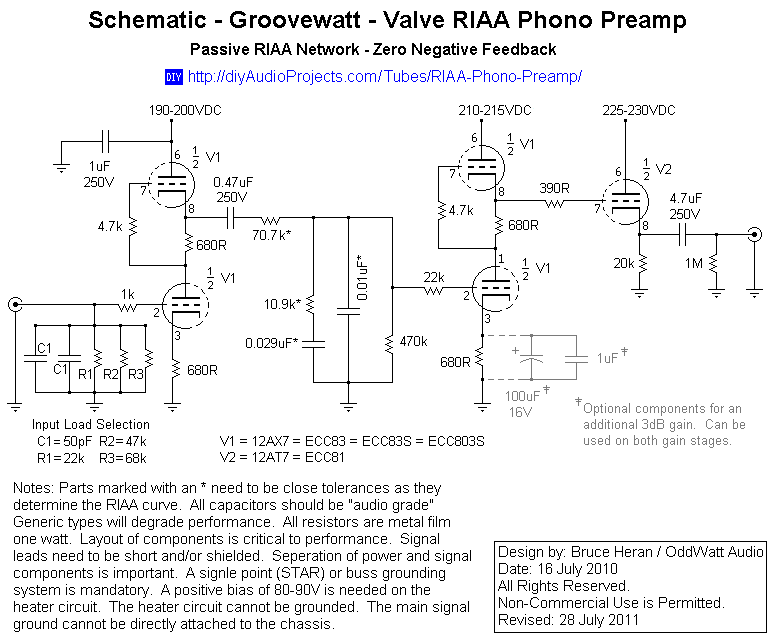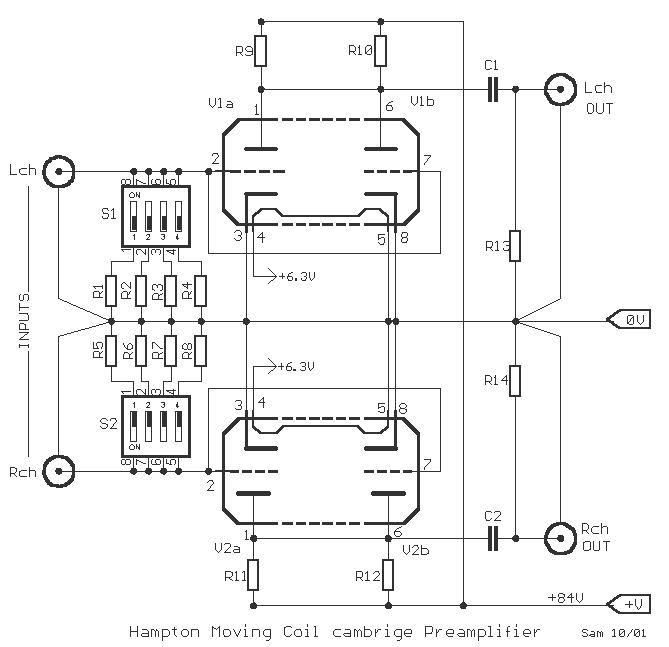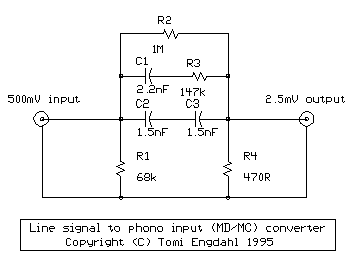
Magnetic-Pickup Phono Preamplifier
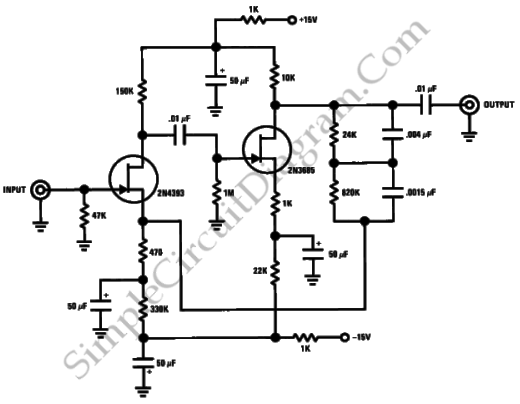
This is a simple circuit for a magnetic pickup phono preamplifier. The circuit provides appropriate loading to a reluctance. Here is the circuit: The gain...
The magnetic pickup phono preamplifier circuit is designed to amplify the low-level audio signals generated by magnetic phono cartridges. These cartridges typically output signals in the millivolt range, which are too weak for direct connection to standard audio equipment. The preamplifier circuit not only amplifies these signals but also ensures that the cartridge operates within its optimal loading conditions, enhancing audio fidelity.
The circuit generally consists of an operational amplifier (op-amp) configured in a non-inverting amplifier setup. The gain of the amplifier can be set using feedback resistors, allowing for customization based on the specific requirements of the magnetic cartridge being used. A typical gain setting might range from 30 to 60 dB, depending on the cartridge's output characteristics.
Input impedance is a critical factor in the design, as it must match the output impedance of the phono cartridge to avoid signal loss and distortion. A high input impedance, often in the range of 47k ohms to 1M ohm, is commonly employed to ensure minimal loading on the cartridge. Coupling capacitors may be used at the input to block any DC offset, allowing only the AC audio signals to pass through to the amplifier.
Additionally, the circuit may include a low-pass filter to eliminate high-frequency noise and a power supply section, typically utilizing a dual power supply to provide both positive and negative voltages necessary for op-amp operation. Proper bypass capacitors should be placed close to the power pins of the op-amp to reduce noise and improve stability.
Overall, this phono preamplifier circuit is essential for achieving high-quality audio playback from vinyl records, ensuring that the delicate signals from the magnetic cartridge are amplified accurately and efficiently.This is a simple circuit of magnetic pickup phono preamplifier. A proper loading to a reluctance is provided by this circuit. Here is the circuit: The gain.. 🔗 External reference
The magnetic pickup phono preamplifier circuit is designed to amplify the low-level audio signals generated by magnetic phono cartridges. These cartridges typically output signals in the millivolt range, which are too weak for direct connection to standard audio equipment. The preamplifier circuit not only amplifies these signals but also ensures that the cartridge operates within its optimal loading conditions, enhancing audio fidelity.
The circuit generally consists of an operational amplifier (op-amp) configured in a non-inverting amplifier setup. The gain of the amplifier can be set using feedback resistors, allowing for customization based on the specific requirements of the magnetic cartridge being used. A typical gain setting might range from 30 to 60 dB, depending on the cartridge's output characteristics.
Input impedance is a critical factor in the design, as it must match the output impedance of the phono cartridge to avoid signal loss and distortion. A high input impedance, often in the range of 47k ohms to 1M ohm, is commonly employed to ensure minimal loading on the cartridge. Coupling capacitors may be used at the input to block any DC offset, allowing only the AC audio signals to pass through to the amplifier.
Additionally, the circuit may include a low-pass filter to eliminate high-frequency noise and a power supply section, typically utilizing a dual power supply to provide both positive and negative voltages necessary for op-amp operation. Proper bypass capacitors should be placed close to the power pins of the op-amp to reduce noise and improve stability.
Overall, this phono preamplifier circuit is essential for achieving high-quality audio playback from vinyl records, ensuring that the delicate signals from the magnetic cartridge are amplified accurately and efficiently.This is a simple circuit of magnetic pickup phono preamplifier. A proper loading to a reluctance is provided by this circuit. Here is the circuit: The gain.. 🔗 External reference
